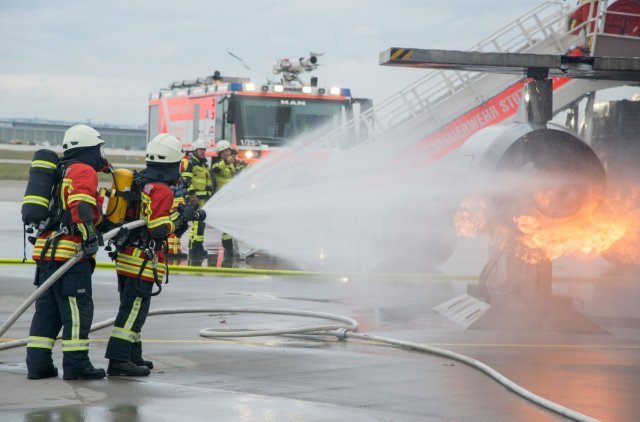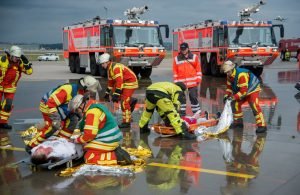
By Holly DeCarlo-White
USAG Stuttgart Public Affairs Office
The U.S. Army Garrison Stuttgart held its annual force protection exercise, Stallion Shake, in partnership with the Flughafen Stuttgart GmbH, or Stuttgart Airport, Oct. 22, at the airport and at Stuttgart Army Airfield.
The U.S. military provides support in emergency management all around the world, but if a disaster were to strike on one of the five military installations in Stuttgart, German host nation first-responders would take the lead working together with U.S. personnel, and various volunteer response teams.
This was the first time the garrison has partnered with the Stuttgart Airport to conduct such a simulated emergency incident response training.
“Stallion Shake is our full-scale exercise in which we test our capability on how we would handle any type of emergency response situation that would happen within our garrison footprint. Each year, we train on a different installation. The importance is really how we work together; our garrison emergency response with our host nation emergency response,” said USAG Stuttgart Commander Col. Glenn K. Dickenson.
Typically, guidance for a military garrison full-scale exercise is provided by the Homeland Security Exercise and Evaluation Program. Stuttgart Airport’s bi-annual requirements fall in accordance with the International Organization for Air Transport (ICAO). In addition to Defense Department evaluators from Vicenza, Italy, the U.S. Army Europe Deputy Commanding General for the Army National Guard, Maj. Gen. John L. Gronski, also attended to observe the events.
Stallion Shake 2016 was designed to assess various aspects of the garrison’s emergency management plan, to include communications, random antiterrorism measures, intelligence information sharing, analysis and the AtHoc emergency mass notification system.
The scenario began for USAG Stuttgart personnel the evening prior to the exercise with a terrorist threat that raised the Force Protection Conditions (FPCON), and triggered the need to increase security measures at each of the installation access control points. The garrison also deployed an AtHoc recall message to stand up an Emergency Operations Center to monitor the situation. The EOC is made up of trained personnel from each directorate of the garrison to ensure communication flows through the proper command channels in any emergency situation.
“AtHoc messages do not just go out – it creates a dynamic that is internal to the garrison to handle any threat that may arise. We all kick into emergency process mode thinking about what we need to do next,” said Daniel W. Spencer of USAG Stuttgart’s Protection Branch.
The events following covered multiple separate training incidents: weather, aircraft inflight emergency, diversion and crash including fire and multi-national passenger evacuation.
Minutes after the crash on the airfield was reported, host nation airport first-responders arrived on scene to extinguish the fire and initiate the rescue and care of the 40 passengers (volunteer actors with simulated injuries) on board.
During this training scenario, the cause of the crash for airport personnel was an obstruction within the plane, such as birds in flight; while for USAG Stuttgart, the incident followed requirements for a terrorist attack.

“Today, we are practicing an aircraft that has had an inflight problem and crashed on the runway. The international airport fire department, our garrison fire department as well as other emergency personnel responded and collectively worked together,” Dickenson said.
The exercise involved a variety of German and American participants to include: USAG Stuttgart’s Directorate of Emergency Services (Military Police and firefighters), the 66th Military Intelligence Criminal Investigation Detachment, the District Government Stuttgart, the Stuttgart Airport Fire Department, Esslingen County and City of Stuttgart fire departments, Police Department Reutlingen, volunteer emergency services departments to include the German Red Cross Esslingen-Nürtingen and the German Red Cross Stuttgart.
“It’s critical how well we can communicate back and forth to support each other,” Dickenson said.
At the conclusion of the exercise, Dickenson emphasized how the flow of information and interaction between participants improved in comparison to last year.
“The intent is to keep the strong relations with the civilian airport fire department…and to continue to improve relations with authorities from Esslingen County and townships surrounding SAAF,” said Karl Dörsam, USAG Stuttgart’s fire chief.
View more photos from Stallion Shake 2016, here.
